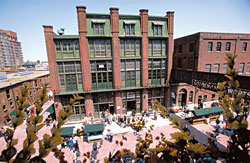Vibrant maple leaves ride on the crest of a cultural wave
The Historic Distillery District in Toronto contains art galleries, pubs and restaurants. DPA |
"And over there," said Bruce with a nod in the direction of the deep freezer. "That was Henrietta's Lane, the city's red light district. We had 6,000 people back then, 60 bars and the same number of bordellos." By now the shop assistants are hanging onto Bruce's every word.
Tourists who take a tour with Toronto's most popular guide learn about the secret side of a city, which for many years was regarded by most outsiders as being conservative and rather dull. It wasn't until after World War II that this metropolis experienced a kind of "coming out". Over the last 40 years immigrants have transformed what used to be paragon of Puritanism into a multi-cultural city.
These days the population of the city is aged on average at around 36 years. There are a dozen ethnic districts with thousands of bars and restaurants. Increased prosperity and the influx of new citizens from abroad have helped establish a thriving cultural life as well.
Toronto now boasts 50 ballet and dance groups, six opera ensembles and two symphony orchestras. Hollywood moviemakers have long since discovered Toronto and the directors of many blockbuster productions have shot on location in the city where the cost of filming is lower.
Culturally speaking, Toronto is currently riding the crest of a wave. Six major attractions have been opened or revamped at a total cost of more than one billion Canadian dollars (around $854 million).
Architect Daniel Libeskind has given the Royal Ontario Museum (ROM) a startling, star-like extension dubbed the "Michael Lee-Chin Crystal", while his colleague Frank Gehry had remodelled the Art Gallery of Ontario (AGO) using plenty of glass and pinewood. With the completion of the Four Season Centre of Performing Arts the Canadian Opera Company and the national ballet have also taken up residence in what is arguably the best opera house on the North American continent.
"We see ourselves as 'Urban Farmers'," says Matthew Rosenblatt, one of the people responsible for Toronto's new pleasure quarter, the Historic Distillery District.
In the 19th century the complex made up of 44 buildings was the world's largest distillery. Today it is home to 14 galleries, artists studios, stages, restaurants and music bars. Particular care was taken to find tenants "who offer quality goods and who share our vision," said Rosenblatt.
The aim is to create a climate, which fosters new ideas and concepts. The complex already offers a wide variety, with the wares on offer ranging from glass sculptures with six-figure price tags through to Japanese furniture and handmade chocolates. Visitors here are supposed to feel as if they are on a voyage of discovery and not just tourists.
When night comes it is time for clubbing. Toronto's jazz scene is among the best in North America. A good venue to wind up an evening is Healey's, the basement bar owned by blind jazz-rocker Jeff Healey.
"Unfortunately Jeff only plays on Thursdays," says someone else sitting at the table and before he or she knows it, the tourist finds himself chatting away to the friendly locals. The man also explains where Toronto got its name. The word Toronto comes from the Iroquois Indian language and means "the place where people meet".
Of course after a day in the city, it wasn't hard to guess that.
DPA
(China Daily 04/19/2007 page19)















